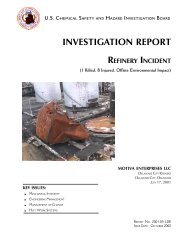CTA Report, Draft 1, ISP Review - US Chemical Safety and Hazard ...
CTA Report, Draft 1, ISP Review - US Chemical Safety and Hazard ...
CTA Report, Draft 1, ISP Review - US Chemical Safety and Hazard ...
Create successful ePaper yourself
Turn your PDF publications into a flip-book with our unique Google optimized e-Paper software.
The production lines had a history of small fires erupting in the ovens. The ovens were not equipped with<br />
internal fire protection such as water sprinklers. Operators routinely put out the fires with garden hoses or<br />
with dry chemical fire extinguishers. They reported that waste material from the production process<br />
typically accumulated in the bottom of the inside of the line 405 oven. NFPA 86, St<strong>and</strong>ard for Ovens <strong>and</strong><br />
Furnaces (2003), recommends evaluating the need to install automatic water sprinklers in ovens that<br />
accumulate appreciable quantities of combustible material (Appendix D.2.1).<br />
8.6.2 Electrical <strong>Safety</strong><br />
Employees reported seeing electrical boxes on the production lines catch on fire <strong>and</strong> blow open on a few<br />
occasions. Insurance inspections in 2001 <strong>and</strong> 2002 warned of the hazard of accumulated dust in electrical<br />
boxes. The boxes on the production lines were not designed to seal tightly, <strong>and</strong> some had holes.<br />
NFPA 499, Recommended Practice for the Classification of Combustible Dusts <strong>and</strong> of <strong>Hazard</strong>ous<br />
(Classified) Locations for Electrical Installations in <strong>Chemical</strong> Process Areas (2004b), recommends that<br />
electrical installations be designed <strong>and</strong> enclosed in a “dust-ignition proof ” manner or be pressurized or<br />
made intrinsically safe (Appendix D.2.2).<br />
NFPA 70, The National Electrical Code (NEC; 2002b), <strong>and</strong> OSHA regulations (29 CFR 1910.307)<br />
classify areas where combustible dusts may be suspended in air as Class II, Division 2. This<br />
classification requires dust-tight electrical equipment to prevent combustible dust from entering electrical<br />
components. The phenolic resins used by <strong>CTA</strong> (based on the CAS number) are listed as Class II, Group<br />
G, 23 materials in Table 4.5.2 of NFPA 499. <strong>CTA</strong> did not have the appropriate dust-tight electrical<br />
equipment. Although electrical equipment likely was not the ignition source for the February 20<br />
explosions, the use of nondust-tight equipment by <strong>CTA</strong> was an unsafe practice.<br />
23 NEC (NFPA, 2002b) divides combustible dusts into three groups. Group G combustible dusts include flour,<br />
grain, wood, plastic, <strong>and</strong> chemical dusts.<br />
76









